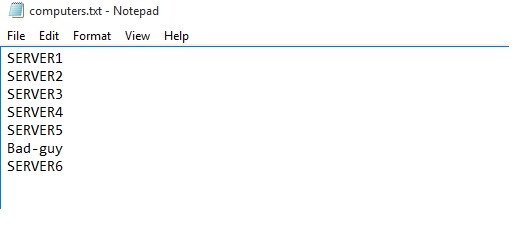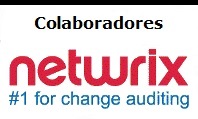#### Spreadsheet Location
$DirectoryToSaveTo = "c:\temp\"
$date=Get-Date -format "yyyy-MM-d"
$Filename="WannaCry_Servers_Patches_status_report"
###InputLocation
$Computers = Get-Content "c:\temp\computers.txt"
# Enter KB to be checked here
$Patchw2k8R2 = "KB4012212"
$Patchw2k8R2MRMAR = "KB4012215"
$Patchw2k8R2MRAPR = "KB4015549"
$Patchw2k8R2MRMAY = "KB4019264"
$Patchw2k12R2 = "KB4012213"
$Patchw2k12R2MRMAR = "KB4012216"
$Patchw2k12R2MRAPR = "KB4015550"
$Patchw2k12R2MRMAY = "KB4019215"
$Patchw2k8 = "KB4012598"
$Patchw2k12 = "KB4012214"
$Patchw2k12MRMAR = "KB4012217"
$Patchw2k12MRAPR = "KB4011551"
$Patchw2k12MRMAY = "KB4019216"
$Patchw2k3 = "KB4012598"
# before we do anything else, are we likely to be able to save the file?
# if the directory doesn't exist, then create it
if (!(Test-Path -path "$DirectoryToSaveTo")) #create it if not existing
{
New-Item "$DirectoryToSaveTo" -type directory | out-null
}
#Create a new Excel object using COM
$Excel = New-Object -ComObject Excel.Application
$Excel.visible = $True
$Excel = $Excel.Workbooks.Add()
$Sheet = $Excel.Worksheets.Item(1)
$sheet.Name = 'Patch status - '
#Create a Title for the first worksheet
$row = 1
$Column = 1
$Sheet.Cells.Item($row,$column)= 'Patch status'
$range = $Sheet.Range("a1","f2")
$range.Merge() | Out-Null
$range.VerticalAlignment = -4160
#Give it a nice Style so it stands out
$range.Style = 'Title'
#Increment row for next set of data
$row++;$row++
#Save the initial row so it can be used later to create a border
#Counter variable for rows
$intRow = $row
$xlOpenXMLWorkbook=[int]51
#Read thru the contents of the Servers.txt file
$Sheet.Cells.Item($intRow,1) ="Name"
$Sheet.Cells.Item($intRow,2) ="status"
$Sheet.Cells.Item($intRow,3) ="Patch status"
$Sheet.Cells.Item($intRow,4) ="OS"
$Sheet.Cells.Item($intRow,5) ="SystemType"
$Sheet.Cells.Item($intRow,6) ="Last Boot Time"
for ($col = 1; $col –le 6; $col++)
{
$Sheet.Cells.Item($intRow,$col).Font.Bold = $True
$Sheet.Cells.Item($intRow,$col).Interior.ColorIndex = 48
$Sheet.Cells.Item($intRow,$col).Font.ColorIndex = 34
}
$intRow++
Function GetStatusCode
{
Param([int] $StatusCode)
switch($StatusCode)
{
0 {"Success"}
11001 {"Buffer Too Small"}
11002 {"Destination Net Unreachable"}
11003 {"Destination Host Unreachable"}
11004 {"Destination Protocol Unreachable"}
11005 {"Destination Port Unreachable"}
11006 {"No Resources"}
11007 {"Bad Option"}
11008 {"Hardware Error"}
11009 {"Packet Too Big"}
11010 {"Request Timed Out"}
11011 {"Bad Request"}
11012 {"Bad Route"}
11013 {"TimeToLive Expired Transit"}
11014 {"TimeToLive Expired Reassembly"}
11015 {"Parameter Problem"}
11016 {"Source Quench"}
11017 {"Option Too Big"}
11018 {"Bad Destination"}
11032 {"Negotiating IPSEC"}
11050 {"General Failure"}
default {"Failed"}
}
}
Function GetUpTime
{
param([string] $LastBootTime)
$Uptime = (Get-Date) - [System.Management.ManagementDateTimeconverter]::ToDateTime($LastBootTime)
"Days: $($Uptime.Days); Hours: $($Uptime.Hours); Minutes: $($Uptime.Minutes); Seconds: $($Uptime.Seconds)"
}
foreach ($Computer in $Computers)
{
TRY {
$OS = Get-WmiObject -Class Win32_OperatingSystem -ComputerName $Computer -ErrorAction SilentlyContinue
$sheetS = Get-WmiObject -Class Win32_ComputerSystem -ComputerName $Computer -ErrorAction SilentlyContinue
$sheetPU = Get-WmiObject -Class Win32_Processor -ComputerName $Computer -ErrorAction SilentlyContinue
$drives = Get-WmiObject -ComputerName $Computer Win32_LogicalDisk | Where-Object {$_.DriveType -eq 3} -ErrorAction SilentlyContinue
$pingStatus = Get-WmiObject -Query "Select * from win32_PingStatus where Address='$Computer'"
$OSRunning = $OS.caption + " " + $OS.OSArchitecture + " SP " + $OS.ServicePackMajorVersion
$systemType=$sheetS.SystemType
$date = Get-Date
$uptime = $OS.ConvertToDateTime($OS.lastbootuptime)
#Check patch for windows server 2008 R2
if ($OSRunning -like "*2008 R2*")
{
if
($kb=get-hotfix -id $Patchw2k8r2 -ComputerName $computer -ErrorAction SilentlyContinue )
{
$kbinstall="$Patchw2k8r2 is installed"
}
elseif ($kb=get-hotfix -id $Patchw2k8r2MRMAR -ComputerName $computer -ErrorAction SilentlyContinue)
{
$kbinstall="$Patchw2k8r2MRMAR is installed"
}
elseif ($kb=get-hotfix -id $Patchw2k8r2MRAPR -ComputerName $computer -ErrorAction SilentlyContinue)
{
$kbinstall="$Patchw2k8r2MRAPR is installed"
}
elseif ($kb=get-hotfix -id $Patchw2k8r2MRMAY -ComputerName $computer -ErrorAction SilentlyContinue)
{
$kbinstall="$Patchw2k8r2MRMAY is installed"
}
else
{
$kbinstall="Not installed $Patchw2k8r2 , $Patchw2k8r2MRMAR , $Patchw2k8r2MRAPR or $Patchw2k8r2MRMAY "
}
}
#Check patch for windows server 2012 R2
elseif($OSRunning -like "*2012 R2*")
{
if
($kb=get-hotfix -id $Patchw2k12r2 -ComputerName $computer -ErrorAction SilentlyContinue )
{
$kbinstall="$Patchw2k12r2 is installed"
}
elseif ($kb=get-hotfix -id $Patchw2k12r2MRMAR -ComputerName $computer -ErrorAction SilentlyContinue)
{
$kbinstall="$Patchw2k12r2MRMAR is installed"
}
elseif ($kb=get-hotfix -id $Patchw2k12r2MRAPR -ComputerName $computer -ErrorAction SilentlyContinue)
{
$kbinstall="$Patchw2k12r2MRAPR is installed"
}
elseif ($kb=get-hotfix -id $Patchw2k12r2MRMAY -ComputerName $computer -ErrorAction SilentlyContinue)
{
$kbinstall="$Patchw2k12r2MRMAY is installed"
}
else
{
$kbinstall="Not installed $Patchw2k12r2 , $Patchw2k12r2MRMAR , $Patchw2k12r2MRAPR or $Patchw2k12r2MRMAY "
}
}
#Check patch for windows server 2012
elseif($OSRunning -like "*2012*" -and $OSRunning -notlike '*R2*' )
{
if
($kb=get-hotfix -id $Patchw2k12 -ComputerName $computer -ErrorAction SilentlyContinue )
{
$kbinstall="$Patchw2k12 is installed"
}
elseif ($kb=get-hotfix -id $Patchw2k12MRMAR -ComputerName $computer -ErrorAction SilentlyContinue)
{
$kbinstall="$Patchw2k12MRMAR is installed"
}
elseif ($kb=get-hotfix -id $Patchw2k12MRAPR -ComputerName $computer -ErrorAction SilentlyContinue)
{
$kbinstall="$Patchw2k12MRAPR is installed"
}
elseif ($kb=get-hotfix -id $Patchw2k12MRMAY -ComputerName $computer -ErrorAction SilentlyContinue)
{
$kbinstall="$Patchw2k12MRMAY is installed"
}
else
{
$kbinstall="Not installed $Patchw2k12 , $Patchw2k12MRMAR , $Patchw2k12MRAPR or $Patchw2k12MRMAY "
}
}
#Check patch for windows server 2008
elseif($OSRunning -like "*2008*" -and $OSRunning -notlike '*R2*' )
{
if
($kb=get-hotfix -id $Patchw2k8 -ComputerName $computer -ErrorAction SilentlyContinue )
{
$kbinstall="$Patchw2k8 is installed"
}
else
{
$kbinstall="Not installed $Patchw2k8"
}
}
#Check patch for windows server 2003
elseif($OSRunning -like "*2003*")
{
if
($kb=get-hotfix -id $Patchw2k3 -ComputerName $computer -ErrorAction SilentlyContinue )
{
$kbinstall="$Patchw2k3 is installed"
}
else
{
$kbinstall="Not installed $Patchw2k3"
}
}
else
{
$kbinstall="Operating system not covered for this script"
}



